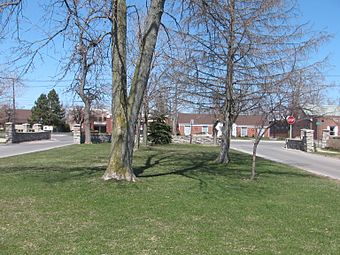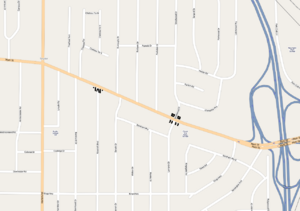Entranceway at Main Street at Roycroft Boulevard facts for kids
Quick facts for kids |
|
|
Entranceway at Main Street at Roycroft Boulevard
|
|

Entranceway at Main Street at Roycroft Boulevard from south, April 12, 2009
|
|
| Location | Main St., jct. with Roycroft Blvd., Amherst, New York |
|---|---|
| Built | 1918 |
| Architect | Abbot and Beymer |
| Architectural style | Tudor Revival |
| MPS | Suburban Development of Buffalo, New York MPS |
| NRHP reference No. | 05001378 |
| Added to NRHP | December 7, 2005 |
The Entranceway at Main Street at Roycroft Boulevard is a special gateway built in 1918. It marks the start of a neighborhood in Snyder, a part of Amherst in Erie County. This entranceway is on Main Street, also known as New York State Route 5.
It shows how country areas near cities became suburbs. This happened as people moved out of crowded cities. The entranceway has several low stone walls. One wall is shaped like a half-circle where Roycroft Boulevard meets Main Street. This historic entranceway was added to the National Register of Historic Places on December 7, 2005.
History of the Area
The town of Amherst was created in 1818. Before that, Williamsville grew around a mill built in 1811. Main Street was the main road connecting Williamsville and Amherst to Buffalo.
Later, other ways to travel became more popular. The Erie Canal opened in 1825. Then, railroads were built next to Main Street. In 1866, the Buffalo Street Railway Company built a streetcar system. It ran on Main Street from Amherst to Buffalo. Stagecoach service also started in 1866. This continued until electric trolleys took over in 1893. The trolley track was about 4.5 miles (7.2 km) long. It had stops like the Entranceways at Main Street at Lamarck Drive and Smallwood Drive.
In the early 1900s, large family estates started to become residential neighborhoods. Suburbs around Buffalo began to look more like small towns. These new neighborhoods were often built along main roads. For example, Charles S. Burkhardt started the Audubon Terrace neighborhood in October 1919. It was built on 400 acres north of Main Street.
Where It Is Today

Today, Main Street is a four-lane road. It runs east and west through Snyder. It connects Williamsville to places like Eggertsville and downtown Buffalo. The entranceway is near large neighborhoods with many trees and grassy areas. These neighborhoods were built in the 1920s. They have wide grassy areas in the middle of the road.
The entranceway is three blocks east of Harlem Road (New York State Route 240). Across Main Street, to the northeast, is the Eggertsville-Snyder Branch Library. It is located at 4622 Main Street. Each side of the grassy middle area on Roycroft Boulevard is for one-way traffic. The entranceway structures are on the two south side corners of this intersection.
How It Looks
The entranceway was finished in 1918. Its main part is a nearly half-circle wall made of rough stone. This wall is on the middle section of Roycroft Boulevard. It is angled about 22 degrees to Main Street.
The wall has one main stone post in the middle and two at the ends. These posts are about 4 feet (1.2 m) tall. They have concrete tops, which are not the original ones. Each post has a modern metal and glass street lamp sticking out. The wall also has stone decorations called pilasters at its quarter points. The top of the wall has a continuous cap that slopes at a 45-degree angle. This cap forms a support, like a small buttress, that is three-quarters the height of the posts.
Some repairs have been made in the past. These repairs used stone and mortar that did not match the original. The Main Street road and the grassy median meet the wall. According to a report from 2005, the entranceway needed repairs. It was missing a visible base and was leaning.
On the sides of Roycroft Boulevard, away from the main half-circle wall, are other stone structures. These also have stone posts and low walls. They are parallel to Roycroft Boulevard. These walls are L-shaped. The longer part runs along Roycroft Boulevard. A shorter part is along Main Street. These walls have capped, square stone posts. Their corners are marked by stone pilasters the same height as the wall.
Across from each of these walls, next to a concrete sidewalk, is a separate stone post. The west side of the entranceway is in good condition. However, the east side is leaning and is in poor condition. The east side has the only original concrete cap. It has a round dip in it. This dip probably once held an original lamp post and was painted white. The south end post on this side has a four-piece white terra cotta cap. It looks like the other non-original end posts.
Its Importance Today
The entranceways are still in their original spot. They still have their original design and surroundings. They continue to mark the entrance to the neighborhood for cars and people, just as they were meant to.
The Abbott and Beymer Land Co. bought the land for the Aurora Park neighborhood. The entranceway has marked this neighborhood since it was built in 1918. The street and plot plans were designed by the Straley Brothers. They were civil engineers and surveyors from Buffalo. George C. Diehl, a county engineer, also helped develop this neighborhood. The entranceway was added to the National Register of Historic Places on December 7, 2005.
Images for kids





